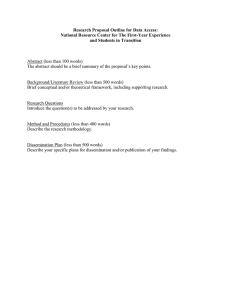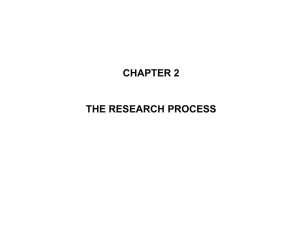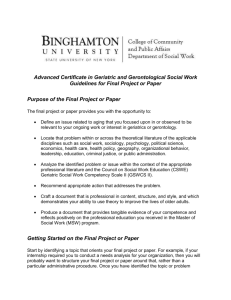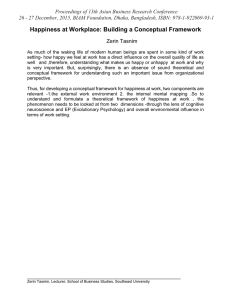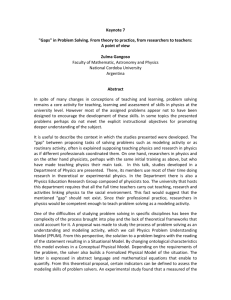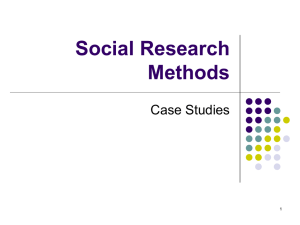Is There a Conceptual Difference between Theoretical
advertisement
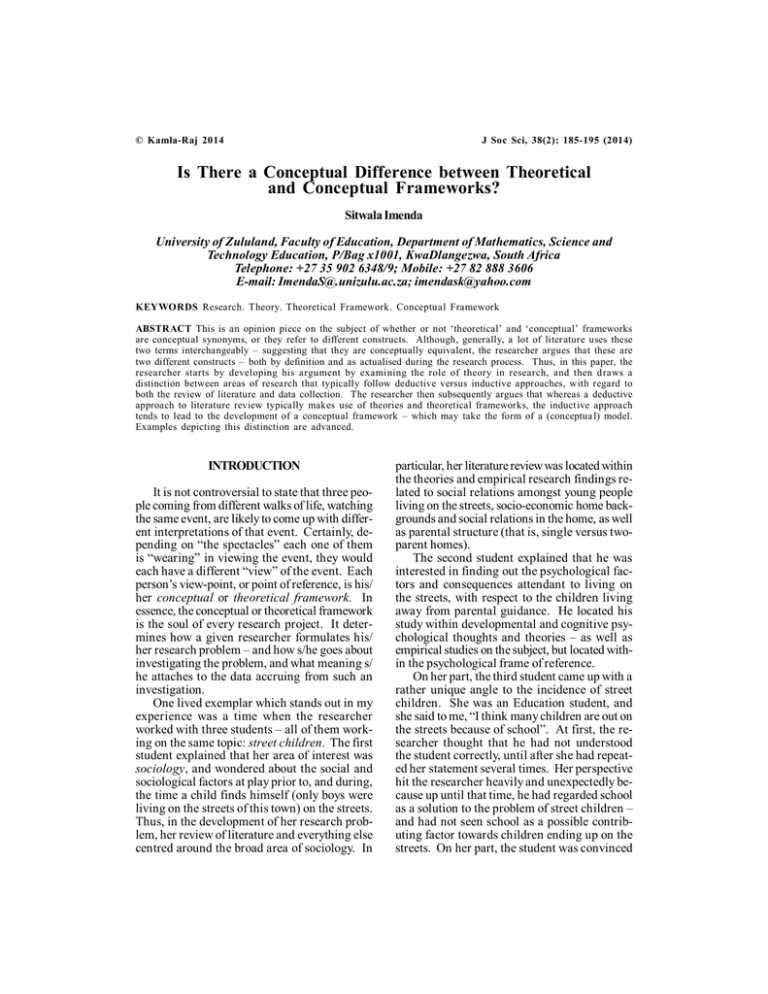
© Kamla-Raj 2014 J Soc Sci, 38(2): 185-195 (2014) Is There a Conceptual Difference between Theoretical and Conceptual Frameworks? Sitwala Imenda University of Zululand, Faculty of Education, Department of Mathematics, Science and Technology Education, P/Bag x1001, KwaDlangezwa, South Africa Telephone: +27 35 902 6348/9; Mobile: +27 82 888 3606 E-mail: ImendaS@.unizulu.ac.za; imendask@yahoo.com KEYWORDS Research. Theory. Theoretical Framework. Conceptual Framework ABSTRACT This is an opinion piece on the subject of whether or not ‘theoretical’ and ‘conceptual’ frameworks are conceptual synonyms, or they refer to different constructs. Although, generally, a lot of liter ature uses these two terms interchangeably – suggesting that they are conceptually equivalent, the researcher argues that these are two different constructs – both by definition and as actualised during the research process. Thus, in this paper, the researcher starts by developing his argument by examining the role of theory in research, and then draws a distinction between areas of research that typically follow deductive versus inductive approaches, with regard to both the review of literature and data collection. The researcher then subsequently argues that whereas a deductive approach to literature review typically makes use of theories and theoretical frameworks, the induct ive approach tends to lead to the development of a conceptual framework – which may take the form of a (conceptua l) model. Examples depicting this distinction are advanced. INTRODUCTION It is not controversial to state that three people coming from different walks of life, watching the same event, are likely to come up with different interpretations of that event. Certainly, depending on “the spectacles” each one of them is “wearing” in viewing the event, they would each have a different “view” of the event. Each person’s view-point, or point of reference, is his/ her conceptual or theoretical framework. In essence, the conceptual or theoretical framework is the soul of every research project. It determines how a given researcher formulates his/ her research problem – and how s/he goes about investigating the problem, and what meaning s/ he attaches to the data accruing from such an investigation. One lived exemplar which stands out in my experience was a time when the researcher worked with three students – all of them working on the same topic: street children. The first student explained that her area of interest was sociology, and wondered about the social and sociological factors at play prior to, and during, the time a child finds himself (only boys were living on the streets of this town) on the streets. Thus, in the development of her research problem, her review of literature and everything else centred around the broad area of sociology. In particular, her literature review was located within the theories and empirical research findings related to social relations amongst young people living on the streets, socio-economic home backgrounds and social relations in the home, as well as parental structure (that is, single versus twoparent homes). The second student explained that he was interested in finding out the psychological factors and consequences attendant to living on the streets, with respect to the children living away from parental guidance. He located his study within developmental and cognitive psychological thoughts and theories – as well as empirical studies on the subject, but located within the psychological frame of reference. On her part, the third student came up with a rather unique angle to the incidence of street children. She was an Education student, and she said to me, “I think many children are out on the streets because of school”. At first, the researcher thought that he had not understood the student correctly, until after she had repeated her statement several times. Her perspective hit the researcher heavily and unexpectedly because up until that time, he had regarded school as a solution to the problem of street children – and had not seen school as a possible contributing factor towards children ending up on the streets. On her part, the student was convinced 186 that there was something about schooling that repelled some children, and because of relentless pressure from home (amongst other factors) forcing them to keep attending school, the affected children rather ended up on the streets. So, in developing her research problem, she located her thinking within a number of theoretical perspectives, including school governance, school curriculum, curricular relevance and implementation, the teacher-learner interface, accessibility of schools (for example, distances the children had to travel, usually walking, to and from school), school environment – including possibilities of bullying, as well as school support and sensitivity to learners’ individual and collective needs. As one may expect, these three studies, carried out on the same accessible population, differed in more respects than they were similar – from problem statements and research questions, all the way to their findings, conclusions and recommendations. The main reason for this was that they each “looked at the circumstances of the same street children from different ‘points of view’ or ‘theoretical / conceptual frameworks’.” Objective This paper explores the two terms: theoretical and conceptual frameworks, with a view to shedding some light on their respective meanings, within the context of research in both the natural and social sciences – particularly with reference to conceptual meaning, purpose, methodology and scope of application. SITWALA IMENDA ic, controlled, empirical, and critical investigation of [natural / social] phenomena, guided by theory and hypotheses about the presumed relations” among such phenomena. (Parenthesis and emphasis added). Accordingly, in research, subjective beliefs are “checked against objective reality” (de Vos et al. 2005: 36). Quite significant to this paper is the highlighted portion of this definition, which specifically states that research is “guided by theory”. The suggestion here is that without ‘theory’ research would lack direction – and this explains why in every research, one is expected to present one’s ‘theoretical’ framework – as the students in the above exemplar did. However, whereas theory directs systematic ‘controlled, empirical’ research, the place of theory in ‘less-controlled’ and ‘non-empirical’ types of research could be conceptually different (Liehr and Smith 1999). In fact, most generative research is conceptually different from research based on hypothesis-testing or hypotheticodeductive reasoning. In effect, most generative research often seeks to develop theories that are ‘grounded in the data collected’ and arising from discovering ‘what is really going on in the field’ (Liehr and Smith 1999). As Cline (2002: 2) observes, “in the case of qualitative studies, a theoretical framework may not be explicitly articulated since qualitative inquiry typically is often oriented toward grounded theory development in the first place”. However, although the place of theory in different research paradigms may vary, still ‘theory’ appears to be central to all forms of research. The question is: what then is ‘theory’? Understanding the Key Concepts Theory In attempting to address the objective of this study, a closer look at the following terms is essential, namely, theory, concept, conceptual framework and theoretical framework. This will help decipher if any conceptual differences exist among these terms. However, since these terms are to be defined within the context of research, it is deemed necessary to start with a definition of research, before these terms are defined and discussed. Research Many definitions of research abound. De Vos et al. (2005: 41) see research as a “systemat- Aspects such as ‘explaining’ and ‘making predictions’ are among the most common features of the definition of ‘theory’. For example, Fox and Bayat (2007: 29) define theory as “a set of interrelated propositions, concepts and definitions that present a systematic point of view of specifying relationships between variables with a view to predicting and explaining phenomena”. Likewise, Liehr and Smith (1999: 8) opine the following about theory: A theory is a set of interrelated concepts, which structure a systematic view of phenomena for the purpose of explaining or predicting. A theory is like a blueprint, a guide for model- THEORETICAL VERSUS CONCEPTUAL FRAMEWORKS ing a structure. A blueprint depicts the elements of a structure and the relation of each element to the other, just as a theory depicts the concepts, which compose it and the relation of concepts with each other. Further, Liehr and Smith (1999: 2) make a connection between theory and practice in their contention that the former guides the latter while, on the other hand, “practice enables testing of theory and generates questions for research; research contributes to theory-building, and selecting practice guidelines”. Accordingly, these two authors posit that a careful interweaving of theory and research could reinforce what is learned through practice, to create the knowledge fabric of the given discipline. Chinn and Kramer (1999: 258) define a theory as an “expression of knowledge….a creative and rigorous structuring of ideas that project a tentative, purposeful, and systematic view of phenomena”. More traditionally, a theory has been defined as “a systematic abstraction of reality that serves some purpose … A creative and rigorous structuring of ideas that project a tentative purposeful, and systematic view of phenomenon” (Chinn and Kramer 1995: 72). To Hawking (1988: 9), “a theory is a good theory if it satisfies two requirements: It must accurately describe a large class of observations on the basis of a model which contains only a few arbitrary elements, and it must make definite predictions about the results of future observations”. He goes on to state that “any physical theory is always provisional, in the sense that it is only a hypothesis; you can never prove it. No matter how many times the results of experiments agree with some theory, you can never be sure that the next time the result will not contradict the theory. On the other hand, you can disprove a theory by finding even a single observation which disagrees with the predictions of the theory.” So, from the above definitions, the three major defining characteristics of a theory are that it (a) is “a set of interrelated propositions, concepts and definitions that present a systematic point of view”; (b) specifies relationships between / among concepts; and (c) explains and / or makes predictions about the occurrence of events, based on the specified relationships. According to Wacker (1998: 363), a theory has four components, namely (a) definition of terms, concepts or variables, (b) a domain to 187 which the theory is applicable, (c) a set of relationships amongst the variables, and (d) specific predictive claims. Putting all these elements together, a theory is therefore a careful outline of ‘the precise definitions in a specific domain to explain why and how the relationships are logically tied so that the theory gives specific predictions” (Wacker 1998: 363-364). Thus, a good theory is taken to be one which gives a very clear and precise picture of events of the domain it seeks to explain. As such, “a theory’s precision and limitations are founded in the definitions of terms, the domain of the theory, the explanation of relationships, and the specific predictions” (Wacker 1998: 364). Quite importantly, Wacker (1998: 365) outlines the ‘virtues’ and ‘key features’ of a good theory as being (a) uniqueness – that is, being distinguishable from others; (b) conservatism – a theory persists until a superior theory replaces it; (c) generalisability – the greater the area a theory can be applied to, the more powerful it is; (d) fecundity – a theory that is more fertile in generating new models and hypotheses is better than one that generates fewer; (e) parsimony – other things being equal, the fewer the assumptions the better; (f) internal consistency – a theory that has identified all the relationships on the basis of which adequate explanations are rendered; (g) empirical riskiness – any empirical test of a theory should be risky; refutation must be possible for a good theory; and (h) abstraction – the theory is independent of time and space, usually achieved by adding more relationships. However, often-times, the meaning of the term ‘theory’ could also be understood from its frequent contrasting with the construct of ‘practice’ (Greek: praxis). Thus, when one exalts the status of a particular theory, one’s detractors would respond by saying something like ‘but that’s just theory’, implying that what one finds in practice is different – suggesting, in turn, that practice is what really counts. However, regarding the tension between theory and practice, there is a view that, over time, there has been a narrowing of conceptual and operational meanings between the two. Further, it is argued that, although theories in the arts and philosophy still refer to ideas rather than directly observable empirical phenomena, in modern science the terms theory and scientific theory are understood to refer to proposed explanations or empirical phenomena. This is best 188 exemplified by the following bold statement made by the American Academy for the Advancement of Science (2010: 1): A scientific theory is a well-substantiated explanation of some aspect of the natural world, based on a body of facts that have been repeatedly confirmed through observation and experiment. Such fact-supported theories are not “guesses” but reliable accounts of the real world. The theory of biological evolution is more than “just a theory.” It is as factual an explanation of the universe as the atomic theory of matter or the germ theory of disease. Our understanding of gravity is still a work in progress. But the phenomenon of gravity, like evolution, is an accepted fact (The National Academies 1999: 2). Although this statement has been criticised for a number of reasons, including its blurring of the lines between theory and fact, the statement itself conveys the Science Academy’s evolved sense of what they take a theory to be – as they further aver: In everyday language, a theory means a hunch or a speculation. Not so in science. In science, the word ‘theory’ refers to a comprehensive explanation of an important feature of nature that is supported by many facts gathered over time. (Quoted by Weisenmiller 2008: 2) Theories have also been defined in respect of their scope, as well as the relative level of abstractness of their concepts and propositions. Thus, theories may be classified as grand, middle range or juts as concepts (Smith 2008). Middle range theories are seen as bigger than individual concepts, but narrower in scope than grand theories and are composed of a limited number of concepts that relate to a limited aspect of the real world. The concepts and propositions of middle range theories are empirically measurable (Smith and Liehr 1999). Grand theories are seen as broadest in scope, less abstract than conceptual models, but comprising concepts which are, nonetheless, still relatively abstract and general. However, the relationships of the concepts in grand theories cannot be tested empirically because they are, still, too general – sometimes even consisting of sub-theories. Overall, it is held that the defining characteristic of a scientific theory is that it makes falsifiable or testable predictions - the relevance and specificity of which determine how potentially SITWALA IMENDA useful the theory is. Accordingly, a purported theory that makes no predictions which can be studied or systematically followed through is of no use. Concept Hornby (2005: 5) contends that “defining concepts is not an innocent exercise. Meanings/ interpretations of concepts are largely influenced by their context. Concepts reflect theoretical concerns and ideological conflicts. Definitions have their defenders and critics”. Nonetheless, be this as it may, Liehr and Smith (1999: 7) have ventured to give a definition of a concept as “an image or symbolic representation of an abstract idea”. Chinn and Kramer (1999: 252) see concepts as the components of theory which “convey the abstract ideas within a theory”; they also see a concept as a “complex mental formulation of experience.” Research Framework First, it is important to understand what a ‘framework’ is, within the context of research. Liehr and Smith (1999: 13) see a framework for research as a structure that provides “guidance for the researcher as study questions are finetuned, methods for measuring variables are selected and analyses are planned”. Once data are collected and analysed, the framework is used as a mirror to check whether the findings agree with the framework or whether there are some discrepancies; where discrepancies exist, a question is asked as to whether or not the framework can be used to explain them. Referring back to the exemplar concerning the three student researchers, within their broad fields they each chose and/or identified ‘frameworks’ to guide them in explaining and interpreting the circumstances of their investigations regarding the street children, with respective levels of academic integrity and acceptability. This is what constitutes a conceptual or theoretical framework –that is, the specific perspective which a given researcher uses to explore, interpret or explain events or behaviour of the subjects or events s/he is studying. Conceptual Versus Theoretical Frameworks Having briefly cast our eye on the definitions of (a) theory and (b) concept, it may now THEORETICAL VERSUS CONCEPTUAL FRAMEWORKS be opportune to attempt to distinguish between the two notions of theoretical and conceptual framework. Theoretical Framework A theoretical framework refers to the theory that a researcher chooses to guide him/her in his/her research. Thus, a theoretical framework is the application of a theory, or a set of concepts drawn from one and the same theory, to offer an explanation of an event, or shed some light on a particular phenomenon or research problem. This could refer to, for instance, the Set theory, evolution, quantum mechanics, particulate theory of matter, or similar pre-existing generalisation – such as Newton’s laws of motion, gas laws, that could be applied to a given research problem, deductively. Conceptual Framework On the other hand, a researcher may opine that his/her research problem cannot meaningfully be researched in reference to only one theory, or concepts resident within one theory. In such cases, the researcher may have to “synthesize” the existing views in the literature concerning a given situation – both theoretical and from empirical findings. The synthesis may be called a model or conceptual framework, which essentially represents an ‘integrated’ way of looking at the problem (Liehr and Smith 1999). Such a model could then be used in place of a theoretical framework. Thus, a conceptual framework may be defined as an end result of bringing together a number of related concepts 189 to explain or predict a given event, or give a broader understanding of the phenomenon of interest – or simply, of a research problem. The process of arriving at a conceptual framework is akin to an inductive process whereby small individual pieces (in this case, concepts) are joined together to tell a bigger map of possible relationships. Thus, a conceptual framework is derived from concepts, in-so-far as a theoretical framework is derived from a theory. Schematically, this may be represented as in Figure 1. Hence, according to Figure 1, whereas a whole theory may serve as one’s theoretical framework, a conceptual framework is normally of limited scope – carefully put together in the form of a conceptual model, and immediately applicable to a particular study. In general, one finds that whereas in the natural sciences one may be guided by, say, the theory of evolution in conducting an investigation that involves classification of unknown fossil specimens, one often finds that in the social sciences, there is no single theory that one can meaningfully use in dealing with, say, academic achievement or challenges of poverty. The illustrations given in Figures 2 and 3 serve as exemplars of this distinction. Figure 2 represents an example of a theoretical framework. In this example, all the concepts that are used to investigate a research problem are drawn from one theoretical perspective –that is, Newton’s Second Law of Motion. [Just for the record, Newton’s Second Law of Motion states that ‘the acceleration of an object as produced by a net force is directly proportional to the magnitude of the net force, in the same direction as the net force, and inversely proportional to the mass of the object’, (Meirovitch 1997: 2)]. Conceptual Framework Conceptual Framework Theoretical Framework A Set of Related Concepts T heory Fig. 1. Derivation of conceptual and theoretical fr amewo r ks Figure 3 presents an example of a conceptual framework. In Figure 3, the researcher came up with a synthesis of concepts and perspectives drawn from many sources. This is what makes this a ‘conceptual’ framework, and what differentiates it from a theoretical framework. To summarise, therefore, both conceptual and theoretical frameworks represent an integrated understanding of issues, within a given field of study, which enables the researcher to address a specific research problem. These theoretical perspectives guide the individual re- 190 SITWALA IMENDA searcher in terms of specific research questions, hypotheses or objectives – leading to a better directed review of literature, the selection / identification of appropriate research methods, and the interpretation of results. Thus, we can have a number of researchers working on the same research problem, as illustrated above with respect to the three studies about street children, where each one of the students investigated the problem from different theoretical / conceptual frameworks, and each coming up with legitimate findings and knowledge claims at the end of it all. Purpose In general, both ‘conceptual’ and ‘theoretical’ frameworks refer to the epistemological paradigm a researcher adopts in looking at a given research problem – as Liehr and Smith (1999: 12) point out, “each of these terms refers to a structure” which guides the researcher. In the same regard, Evans (2007: 8) opines that both “theoretical and conceptual frames” help the reader understand the reasons why a given researcher decides to study a particular topic, the assumptions s/he makes, how s/he conceptually grounds his/her approach, the scholars s/he is in dialogue with, who s/he agrees and disagrees with. Hence, Evans opines that these two constructs serve the same purpose, suggesting that it is extremely important for every researcher to identify or develop, as well as describe an appropriate conceptual or theoretical framework. Without one, a study lacks proper direction and a basis for pursuing a fruitful review of literature, as well as interpreting and explaining the findings accruing from the investigation. Newton’s Second Law of Motion Force Gravity Vectors Weight Mass Acceleration Motion Fig. 2. An example of a Theoretical Framework METHODOLOGY AND OBSERVATIONS Methodological considerations refer to the research design and the process of addressing a given research problem – including the approach to literature review, the nature of the data to be collected, analysed and interpreted. Inevitably, these issues also touch on the broader discussion of research paradigms, given that the types of research problems pursued, methods of investigation employed, the types of data collected, analysed and interpreted – as well as the underlying epistemological assumptions under the two dominant research paradigms (that is, qualitative and quantitative) are typically not the same. Thus, starting with the type of research problem to be addressed, it may be said that whereas some research problems may be studied through processes and procedures that meaningfully produce findings “arrived at by statistical procedures or other means of quantification”, studies involving people’s ways of life, “lived experiences, behaviors, emotions, and feelings as well as about organizational functioning, social movements, cultural phenomena, and interactions between nations” (Strauss and Corbin, 1998: 10-11) are better studies in ways that generate qualitative data that are mainly descriptive and interpretative. In this regard, Strauss and Corbin (1998: 11) opine that although some researchers quantify qualitative data, obtained through techniques normally associated with qualitative research – such as interviews and direct observation techniques, qualitative data analysis refers “not to the quantifying of qualitative data but rather to a nonmathematical process of interpretation, carried out for the purpose of discovering concepts and relationships in raw data and then organizing these into a theoretical explanatory scheme”. Smith (2008: 4) defines paradigms as “schools of shared assumptions, values and views about the phenomena addressed in particular sciences”. The Quantitative and Qualitative research paradigms are the most commonly cited by researchers (Denzin, 1978; Dzurec and Abraham 1993; Johnson and Onwuegbuzie, 2004; Guba and Lincoln 2005). However, Schwandt (2000: 206) has taken issue with these “paradigm wars,” calling into question the need for this division or differentiation. In his words, “it is highly questionable whether such a distinction is any longer meaningful for helping us THEORETICAL VERSUS CONCEPTUAL FRAMEWORKS 191 Fig. 3. An example of a conceptual framework [Source: Coetzee A 2009. Overcoming alternative conceptions concerning interference and diffraction of waves. D. Ed thesis, Tshwane University of Technology, Pretoria, p. 135. Reproduced with permission.] understand the purpose and means of human inquiry” (2000: 210). Schwandt (2000: 210) further observes as follows: All research is interpretive, and we face a multiplicity of methods that are suitable for different kinds of understandings. So the traditional means of coming to grips with one’s identity as a researcher by aligning oneself with a particular set of methods (or being defined in one’s department as a student of “qualitative” or “quantitative” methods) is no longer very useful. If we are to go forward, we need to get rid of that distinction. This point is supported by Johnson et al. (2007: 117) in their observation that “antagonism between paradigms is unproductive”. But they go further and posit that the integration of these two research paradigms gives birth to a third research paradigm: Mixed methods research is an intellectual and practical synthesis based on qualitative and quantitative research; it is the third methodological or research paradigm (along with qualitative and quantitative research). It recognizes the importance of traditional quantitative and qualitative research but also offers a powerful third paradigm choice that often will provide the most informative, complete, balanced, and useful research results. (Johnson et al. 2007: 129). In the light of the above views of Schwandt’s, as well as Johnson et al. it appears reasonable to lay some emphasis on the “mixed methods” (blended) research paradigm – which Johnson, et al. (2007: 113) define as “an approach to knowledge (theory and practice) that attempts to consider multiple viewpoints, perspectives, positions, and standpoints (always including the standpoints of qualitative and quantitative research)”. 192 Although the mixed methods research design in not new, it represents a new movement seeking to formalize “the practice of using multiple research methods” (Johnson et al. 2007: 113). Johnson et al. further report that in the history of the development of research methods, this research design was first associated with the term multiple operationalism, as far back as the 1950s. Later the term ‘triangulation’ was coined – which is defined by Denzin (in Johnson et al. 2007: 114) as “the combination of methodologies in the study of the same phenomenon. Accordingly, mixed methods research is the class of research where the researcher mixes or combines quantitative and qualitative research techniques, methods, approaches, and concepts or language into a single study or set of related studies”. Johnson and Onwuegbuzie (2004: 15) earlier stated the following in defining mixed methods research: If you visualize a continuum with qualitative research anchored at one pole and quantitative research anchored at the other, mixed methods research covers the large set of points in the middle area. If one prefers to think categorically, mixed methods research sits in a new third chair, with qualitative research sitting on the left side and quantitative research sitting on the right side”. So, it may then be said that we no longer have just two dominant research paradigms, but three – with the third one having a much greater potential for explaining reality more fully than is possible when only one research paradigm is used. Now, relating this to the process of research, it is not contentious to state that theoretical or conceptual frameworks form the crux of the literature review component of any research project. Thus, in attempting to decipher the methodological difference between theoretical and conceptual frameworks it is important to look at the ways in which a particular study is conducted with regard to the two dimension sets of deductive and inductive development and presentation of literature review. Evidently, research in the behavioural sciences has, over the years, borrowed heavily from the natural sciences. Thus, one would argue that the term ‘theoretical framework’ as used in the social sciences has its genesis in the ‘scientific method’, which appears to have greatly influenced the social sciences, particularly in the earlier years. Had it not been for this, most re- SITWALA IMENDA search in the social sciences would probably not have used the term because what appears to be applicable in most cases is ‘conceptual framework’. In the same vein, it may also be important to reflect on the use of the deductive-inductive research process within the quantitative and qualitative research paradigms Starting with the deductive-inductive approaches, de Vos et al. (2005: 47) opine that deduction “moves from the general to the specific. It moves from a pattern that might be logically or theoretically expected to observations that test whether the expected pattern actually occurs”. In this vein, Liehr and Smith (1999) associate most theoretical frameworks with quantitative research, which in turn tends to rely on deductive reasoning, whereas most conceptual frameworks are associated with qualitative research – mainly utilising inductive reasoning. Thus, a researcher following a deductive approach starts by specifying the theory guiding the study – in the process, citing the main points emphasized in the theory, and illustrating how the main aspects of the theory relate to the research problem. In giving an exposition of the theory, one needs to bring into the discussion the main proponents and detractors / critics of the theory in order to offer a balanced argument. However, it helps when a researcher successfully demonstrates that despite criticisms of the theory, it is nonetheless supported by other experts in the field, particularly with regard to research problems of the class of the one the researcher is pursuing. Figure 4 illustrates the interplay among the three sets of dimensions of (a) deductive versus inductive reasoning, (b) conceptual versus Quantitative Research Problem Identify Reevant Theoretical Structure (TF) (Deductive Approach) Apply TF to Research Problem Qualitative Research Problem Synthesize Relevant Concepts from Various Sources (CF) (Inductive Approach) Apply CF to Research Problem Fig. 4. Typical relationships between the Theoretical Framework (TF) and Conceptual Framework (CF) relative to the qualitative and quantitative research paradigms. 193 THEORETICAL VERSUS CONCEPTUAL FRAMEWORKS Table 1: A summary of the conceptual difference s betwe en conc eptual and theo retical trameworks Variable Conceptual framework Theoretical framework Genesis (a) Created by the researcher from a variety of conceptual or theoretical perspectives;(b) Purpose (a) Helps the researcher see clearly the main variables and concepts in a given study; (b) Provides the researcher with a general approach (methodology – research design, target population and research sample, data collection & analysis); (c) Guides the researcher in the collection, interpretation and explanation of the data, where no dominant theoretical perspective exists (d) Guides future research – specifically where the conceptual framework integrates literature review and field data. Synthesis of relevant concepts. Evolves, or ‘takes shape’, from reviewed literature and/or the data collected. Adopted / adapted from a pre-existing theory or theoretical perspective. (a) Helps the researcher see clearly the main variables and concepts in a given study; Conceptual Meaning Process Underlying (a) Mainly inductive, as in social sciences Review of where research problems cannot ordinarily Literature be explained by one theoretical perspective; (b) Some social science research also gets driven by theories, but theories in the social sciences tend not to have the same ‘power’ as those in the natural sciences. Methodological (a)May be located in both quantitative and Approach qualitative research paradigms; increasingly, mixed-methods approaches are recommended; (b) Data mostly collected through both empirical and descriptive survey instruments, interviews and direct observations – hence, a preponderance of qualitative data; (c) Strong on consideration of context. Scope of Limited to specific research problem and Application or context. theoretical frameworks, relative to (c) qualitative and quantitative research paradigms. Thus, in deductive research, researchers normally use a dominant theory to address a given research problem, while in inductive research, many aspects of different theoretical perspectives are brought together to build up a generalisation with enough “power” to guide the study (Liehr and Smith 1999: 13). Thus, induction “moves from the particular to the general, from a set of specific observations to the discovery of a pattern that represents some degree of order among all the given events … In inductive reasoning people use specific instances or occurrences to draw conclusions about entire classes of objects or events” (de Vos et al. 2005: 47). (b) Provides the researcher with a general pproach (methodology – research design, a target population and research sample, data collection & analysis); and (c) Guides the researcher in the collection, interpretation and explanation of the data. Application of a theory as a whole or in part. Mainly deductive, as in the natural sciences where hypothesis testing takes place to verify the ‘power’ of a theory. (a) Located mainly in the quantitative research paradigm; (b) Data collected mainly through experimental designs, empirical surveys and tests; (c) Efforts made to standardize context, or else ignore it. Wider application beyond the current research problem and context. Accordingly, in inductive reasoning, the research framework (that is, conceptual framework) emerges as the researcher identifies and pieces together the relevant concepts from both theoretical perspectives and empirical findings on the topic with, so to speak, “an open mind”. Accordingly, the inductive approach to literature review involves the reading of many individual theoretical perspectives and reports. From these readings, one identifies a basket of salient concepts and principles which one can reasonably use to address the research problem. As such, a conceptual framework is synthesised from a number of concepts, research findings and theoretical perspectives – some of which may be in opposition or competition with one another. The reason for this is that, typically, in 194 SITWALA IMENDA most social science research – in contrast to research in the natural sciences, there is no one theory that can adequately direct the researcher to sufficiently answer the research questions being pursued. The above points are aptly summarised by Borgatti (1999: 1) in his statement that “theoretical frameworks are obviously critical in deductive, theory-testing sorts of studies”. Hence, in trying to distinguish between theoretical and conceptual frameworks one may say that, whereas research based on deductive reasoning makes use of a pre-existing theory, or theoretical framework, research based of inductive reasoning tends to be ‘theory-building’. SCOPE OFAPPLICATION Both ‘conceptual’ and ‘theoretical’ frameworks refer to the epistemological paradigm a researcher uses to look at a given research problem. However, the scope of conceptual frameworks is usually applicable only to the specific research problem for which it was created. Application to other research problems may be limited. Since theoretical frameworks refer to the application of theories, they tend to have a much wider scope of use beyond one research problem. Table 1 summarises the points made in this paper. According to Table 1, the differences between theoretical and conceptual frameworks lie in their genesis, conceptual meanings, how they each relate to the process of literature review, the methodological approaches they evoke and their scope of application. Once a conceptual framework has been established, the purpose is largely similar to that of a theoretical framework. However, where a conceptual framework ‘shapes up’ from a synthesis of existing literature and freshly collected data, such a conceptual framework tends to serve as a springboard for further research. Cumulatively and over a period of time, the findings of these researches may lead to an articulation of a theory – from which a theoretical framework may, thus, evolve. CONCLUSION This paper has argued that, within the context of research, both conceptual and theoretical frameworks serve the same purposes, namely: (a) to help the researcher see clearly the main variables and concepts in a given study, (b) to provide the researcher with a general approach (methodology – research design, target population and research sample, data collection and analysis), and (c) to guide the researcher in data collection, interpretation and explanation. In essence, a researcher’s conceptual or theoretical framework guides what the person ‘notices’ during the course of data collection or as an event takes place; it is also responsible for what the person ‘does not notice’ – suggesting that people may not notice or observe things which fall outside their conceptual / theoretical frameworks. Thus, in as much as one’s theoretical / conceptual framework serves as spectacles through which to see the world, at the same time, it places boundaries on one’s vision and horizons. A further point is that although both conceptual and theoretical frameworks serve the purposes as specified above, there are differences between them, conceptually, methodologically and with regard to the scope of their application. REFERENCES Borgatti SP 1999. Elements of Research. From< http:/ /www.analytictech.com/mb313/elements.htm.> (Retrieved on August 17, 2010). Chinn PL, Kramer MK 1999. Theory and Nursing: A Systematic Approach. 5 th Edition. St Louis, USA: Mosby. Cline D 2002. Logical Structure, Theoretical Framework. EducationLeadership Center for Excellence. From <Http://Education.Astate.Edu.> (Retrieved on 18 October 2011). Coetzee A 2009. Overcoming Alternative Conceptions Concerning Interference and Diffraction of Waves. DEd Thesis. Pretoria: Tshwane University of Technology. Denzin NK 1978. The Research Act: A Theoretical Introduction to Sociological Methods. New York: Praeger. Dzurec LC, Abraham JL 1993. The nature of inquiry: Linking quantitative and qualitative research. Advances in Nursing Science, 16: 73-79. Fox W, Bayat MS 2007. A Guide to Managing Research. Cape Town: JUTA and Co Ltd. Shredding. Guba EG, Lincoln YS 2005. Paradigmatic controversies, contradictions, and emerging confluences. In: NK Denzin, YS Lincoln (Eds.): The Sage Handbook of Qualitative Research. 3 rd Edition. Thousand Oaks, CA: Sage, pp. 191-215. Hawking S 1988. A Brief History of Time: The Updated and Expanded Tenth Anniversary Edition. New York: Bantam Press. Johnson RB, Onwuegbuzie AJ 2004. Mixed methods research: A research paradigm whose time has come. Educational Researcher, 33(7): 14-26. THEORETICAL VERSUS CONCEPTUAL FRAMEWORKS Johnson RB, Onwuegbuzie AJ, Turner LA 2007. Toward a definition of mixed methods research. Journal of Mixed Methods Research, 1(2): 112-133. Liehr P, Smith MJ 1999. Middle range theory: Spinning research and practice to create knowledge for the new millennium. Advances in Nursing Science, 21(4): 81-91. Schwandt TA 2000. Three epistemological stances for qualitative inquiry. In: NK Denzin, YS Lincoln (Eds.): Handbook of Qualitative Research. 2 nd Edition. Thousand Oaks, CA: Sage, pp. 189-213. Smith MJ 2008. Disciplinary perspectives linked to middle range theory. In: MJ Smith, PR Liehr (Eds.): Middle Range Theory for Nursing. 2 nd Edition, New York: Springer Publishing Company, pp. 3-14. 195 Smith MJ, Liehr P 1999. Attentively embracing story: A middle-range theory with practice and research implications. Research and Theory for Nursing Practice, 13(3): 187-204. Strauss A, Corbin J 1998. Basics of Qualitative Research: Techniques and Procedures for Developing Grounded Theory. 2 nd Edition. Thousand Oaks, CA: Sage. Wacker JG 199 8. A definition of theory: Research guidelines for different theory-building research methods in opera tions management. Jou rnal of Operations Management, 16: 361-385. Weisenmiller M 2008. Florida Considers Laws Supporting “Intelligent Design”. Teaching, Monitor, Issue 169, August7. From <http://www. albionmonitor. com/ 0805a/copyright/floridaintelligentdesign. html.>

